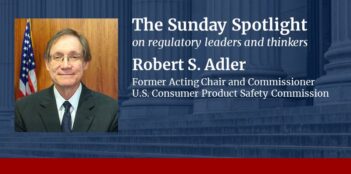
Firms vary considerably in how they interpret regulatory commands and signals, posing enforcement challenges.
Regulators face daunting challenges in seeking compliance, including gaining consensus among competing sources of power and finding adequate resources. Rarely is the probability of detection or likely penalty sufficient to ensure the compliance of a regulated entity. One recent study, for example, showed that sanctions applied under the Foreign Corrupt Practices Act—normally via settlements or deferred prosecutions—may be only one-ninth of what is optimal at present rates of detection.
Some regulatory theorists and social scientists hope to achieve better compliance rates by using expressive appeals, counting on the legitimacy of their message to induce adherence even in the absence of enough compulsion. Indeed, there is a case for such an expectation—perceived legitimacy is important.
But a message’s legitimacy is socially constructed, and, in large firms, it is also organizationally constructed. Firms vary considerably in how they interpret regulatory commands and signals. Self-deception plays a key role in explaining this variation. Both cognition and culture filter regulatory messages in ways that, too often, distort them. The distortion allows firms and their managers to compete aggressively, skirting rules but without the heavy baggage of remorse or other normative distractions.
Self-deception comes in a variety of forms. Overconfidence, the best known, provides a good explanation for the wide variety of positive economic outcomes that accompany outsized risks, such as regulatory violations. When regulatory enforcement becomes lax, overconfidence pays off greatly. In-house risk takers gain status and power, becoming evangelists for taking even more risk. I suspect that a close look at promotion decisions in banks during the run-up to the financial crisis would confirm that fortune favored the overconfident risk-takers and self-believers. But unfortunately, as the sociobiologist Robert Trivers has written, self-deception enables the deception of others.
Other adaptive biases include competitive arousal, motivated reasoning, and the exercise of moral wiggle-room. The more creative the person, the more cleverly—albeit unconsciously—those biases can be put to use.
How are regulatory messages distorted by self-deception? Those with power, especially, are likely to consider themselves responsible and law-abiding, even sanctimonious. Just think of the various ways that minds and cultures can spin stories about what regulation means, why it happens, and whether it seems fair, the latter being a particularly strong determinant of legitimacy. During the Enron scandal, for example, there was ample evidence of an organizational mindset that financial accounting standards had become archaic and mindless, against which sly steps in the name of “fair value” would be morally neutral, or even good in a (self-serving) revolutionary sense.
I was struck by something similar at work in another recent study that asked whether having senior executives who lean either Democrat or Republican has collateral consequences in terms of regulatory compliance. Although the effects of party affiliation were not immense, Republican-led corporations were noticeably charged with more environmental and employment regulatory violations; Democrat-led corporations were more susceptible to financial misreporting and intellectual property claims against them. In terms of different filters, that result seems entirely plausible.
In a new book, Selling Hope, Selling Risk: Corporations, Wall Street and the Dilemmas of Investor Protection, I explore the role of self-deception in affecting compliance with financial regulation, especially securities law. Investors fool themselves, but so do those on the sell-side. In writing the book, it occurred to me that the points about human nature and organizational culture are important not just for compliance with financial regulation, but with regulation more generally. We can use these same insights to turn the mirror on regulators and develop a more realistic portrait of regulatory ambition, cultural capture, and other contemporary ways of viewing agency action and inaction.
Some classic law and society work sheds some light on organizational construction of law, especially Lauren Edelman’s studies of how equal opportunity law is internalized—or not—in human relations departments. The explanations are mixed but they are consistent with filtration. It might be possible for regulation to enhance legitimacy by embedding double agents in the form of empowered compliance departments which have a vested interest in taking regulation seriously, and—perhaps—conferring on it greater legitimacy.
Indeed, this theory of organizational construction may be behind the increase in regulatory attention to so-called cultures of compliance. The Justice Department now makes organizational attitude part of the charging decision and sanctioning process. Likewise, various regulatory agencies, such as the Federal Reserve Bank of New York, the Securities and Exchange Commission (SEC), and its self-regulatory partner, the Financial Industry Regulatory Authority (FINRA), are now making culture part of the inquiry into whether firms have adequate supervisory or risk management procedures in place. The goal appears to be a thorough cleaning of cognitive and organizational filters.
These efforts are potentially promising. But the general approach is horribly under-theorized, borne more out of regulatory frustration than savvy or hard evidence. If cultures are to root out the self-deception and other beliefs that crowd out character in the name of competitive success, we need to understand the processes far better than we yet do. As it stands, compliance norms threaten beliefs, behaviors, and cultural tropes that are instinctively success-producing. But some firms do compliance better than others, and presumably much can be learned from them.
No regulator can completely control the message in a noisy, partisan world. Indeed, research shows that partisanship itself connects to overconfidence, and both are on the rise. Cynical scripts about regulation can be hard to edit, especially with today’s dark national discourse about government competence. But it is worth making the effort. Indeed, that makes the work being done under an interdisciplinary mash-up of headings—behavioral ethics, in particular—so important.
Ever so slowly, we are learning more about how people in business internalize norms about legal and ethical risk-taking. Additional research on this phenomena may provide valuable intelligence for crafting better regulatory strategies and messages.




